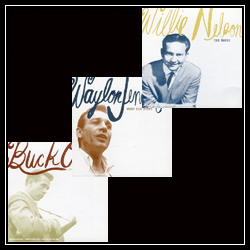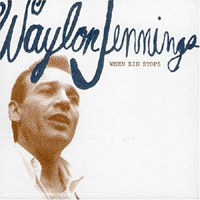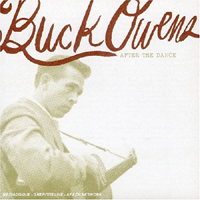|
|
 |

|
 |
Dusted Features
Dusted's Nathan Hogan surveys the first three releases from country reissue label The Masked Weasel: early recordings from legends Willie Nelson, Waylon Jennings, and Buck Owens.
|
|
|
 |
Rebels' First Steps
As part of the family of Oakland-based reissue labels that includes 4 Men with Beards and DBK Works, country imprint The Masked Weasel got rolling this spring by unveiling a treasure trove of rare recordings from Willie Nelson, Waylon Jennings, and Buck Owens. Nelson’s The Ghost, Jennings’ When Sin Stops, and Owens’ After the Dance are comprised of early demos and limited release recordings that predate the singers’ best-known works. The Masked Weasel plans to continue on with similar collections by Patsy Cline and Porter Wagoner, but it’s intriguing that they started with this country triumvirate. As collaborators and close friends, Waylon and Willie are often mentioned in the same breath, but Owens – the poster boy for Wynn Stewart’s famous Bakersfield Sound – made his biggest splash a decade earlier and a half-continent away. Nevertheless, it’s instructive to consider these three musicians as kindred spirits, especially during the transitional periods that these three collections work to illuminate. All three men bucked the Nashville Music Row status quo to rewrite the rules of country. All three spent time forging a personal sound that would sustain them artistically and financially. And all three were rewarded with levels of popular success that must have seemed unimaginable to the sons of abjectly impoverished Texan parents.

The clean-cut, smartly dressed figure on the cover of The Ghost must be the same Willie Nelson who reluctantly quit his job teaching Sunday school to pursue music, but you’d hardly recognize him as the Willie of today. Absent his copper beard, shoulder-length braids, and trademark bandana the singer’s weak chin and wide grin make him look sweetly froggy. However hard his face is to pin down, though, there’s no mistaking the calm, reedy baritone that meanders with deceptive nonchalance through these sixteen songs from the 1960’s and 70’s.
“A lot of people think I sing nasal,” wrote Nelson in his 1988 autobiography. “It’s not true. It may sound nasal to some ears, but actually it’s the strength that comes from deep down in the diaphragm. That’s where you get the most strength.” Raised on an unlikely diet of Hank Williams and Frank Sinatra, Nelson learned to blend the honky tonk heartache of the country superstar with the technical chops of the pop singer. He must have figured it out early, too, because the songs collected on The Ghost exhibit the virtuosic phrasing for which Willie is best known. “I Let My Mind Wander”, with its sleepy waltz-time and syrupy steel guitar, is the ideal arena for the singer to show off his peculiar laze. Deftly shadowing the beat in his characteristically idle fashion, Willie lulls with a soothing imprecision (“I let my mind wander and what did it do? / It just kept on goin’ until it got back to you”). The song is structured and delivered like a cross between Santo & Johnny’s “Sleepwalk” and “Crazy”, which he famously penned for Patsy Cline during his lucrative years as a Nashville songwriter. Other songs, like the little-known “I Didn’t Sleep a Wink Last Night” and “Rainy Day Blues”, more nakedly reveal the debt that Nelson owes to the jazz singers and Tin Pan Alley pop stars he first heard as a child.
Today it’s hard to believe that Nashville bigwigs couldn’t fathom that there was room in country for a voice so gentle and generous as Willie’s––a voice that casually bridges the gap between so many disparate styles of American music. Recognized early on as a songwriting genius by the likes of Hank Cochran and Chet Atkins, it took Nelson more than a decade to prove that he could cut it as a recording artist. An early version of “Night Life”––a song Willie sold for $150 to Ray Price, who later turned around a netted a fortune with it––is featured roughly halfway through The Ghost. It’s outstanding: Willie slinks chameleon-like through the poised, silky verses, coiling world-weary defeat into the sing-speak chorus (“The night life / Ain’t a good life / But it’s my life”), then dropping the lyric at the foot of some nifty blues guitar work. At the other end of the spectrum, the gorgeous “Will You Remember Mine” has Nelson using his offbeat phrasing and mellifluous tone to show a disarming vulnerability. By the late 1960’s, Willie had already found six-figure success as a songwriter. “I could’ve laid down,” he told one interviewer, “but I guess I was just too stubborn. I wanted to pick and sing, and I wanted to be known as a good picker and a good singer. I wasn’t satisfied with just bein’ a songwriter”. The Ghost holds the proof that the A&R men overlooked––that the man who was penning those million dollar songs was the man best fit to deliver them.

When Waylon Jennings recorded “Jole Blon” and “When Sin Stops”, the final two tracks on When Sin Stops, he must have suspected that he was on the threshold of stardom. Fellow Texan Buddy Holly, already revered internationally, had arranged to fly saxophonist King Curtis down from New York for some session work, and he wanted to get Jennings––a friend and local radio DJ––in on the action. As it’s told in R. Denisoff’s Waylon biography, Holly had long admired the smoldering Cajun standard “Jole Blon”, but he recognized that his hiccupping vocal style wasn’t a natural fit for the waltz’s soulful drawl. Enter Jennings: the parochial West Texan didn’t speak French and hadn’t recorded a note, but his hillbilly leanings seemed like a better match for the material. Holly resolved to fiddle with the knobs while Jennings slurred the lyrics bravely (albeit mostly unintelligibly) and Curtis belched beautifully brassy squawks over a shuffling, giddy-up beat. The resulting two minutes (which, in all fairness, should probably have been billed to Curtis) succeed as a curious arrangement of disparate parts and styles battling one another for supremacy. The song’s also a good deal better than the more blatantly Holly-indebted “When the Sin Stops”, a honky tonk crooner that relegates Curtis to the background while foregrounding Jennings’ uncertain, self-effacing vocals. These two tracks, the A and B-sides of Jennings’ first single, are a concise summation of the country outlaw’s early career. More than a decade away from the realization that his smooth-as-bourbon baritone would be powerful enough to rudder somber melodies without boilerplate backing from session players, Jennings thrashed about in search of a model, always playing catch-up to the singers he sought to emulate. When the Sin Stops documents Jennings’s grasping, but more often than not he’s a step or two away from making the songs his own.
“Jole Blon” didn’t hit radio stations until March 1959. Only a month prior, the four-seat Beech bonanza carrying Holly, Ritchie Valens, and J.P. “Big Bopper” Richardson crashed in an Iowa cornfield, killing all aboard. By all accounts, the shockwaves from the crash haunted Jennings for the rest of his life––as a traveling member of Holly’s Crickets, Jennings had lost his seat on the plane over a coin-flip with Richardson, and the brush with death deepened the creases in the rebel singer’s stony visage. “Jole Blon” was quickly buried by more popular radio hits, and Jennings retired to Phoenix, Arizona where he pulled pranks as a radio DJ and found it difficult to hold down even the most menial jobs.
The remainder of When the Sin Stops was recorded five years later, in1964, as Jennings occupied himself with putting together the pieces of his tattered, early career. No longer Buddy Holly’s protégé, Jennings started over from scratch, inking an inauspicious contract with A&M and performing regularly at a venue called JD’s. It was here-––a nightclub and restaurant that drew Arizona cowboys, college-aged hippies, and polished businessmen––that Jennings was forced to draw on myriad influences in order to please a diverse clientele. Roy Orbison’s “Crying”, Bob Gibson’s “Abilene”, The Big Bopper’s “White Lightning” and Dylan’s “Don’t Think Twice” are a few of the cuts that peppered Jennings’ set lists––all appear on the 1964 album Waylon at JD’s, and again on When the Sin Stops. “Crying” and “Don’t Think Twice” are among the best of an odd, chameleonic lot. Enshrouded in a wispy fog of reverb, “Crying” could go toe-to-toe with the Orbison staple: mallets rumble out a pillowed rhythm, and Jennings’ rich, expressive baritone seems to iron everything flat, gazing back on unhappiness with a glassy but resonate remove. “Don’t Think Twice” was covered so many times that Jennings didn’t bother wasting energy trying to mimic Dylan (or Johnny Cash, or the Four Seasons). Unfortunately mimicry is a trap that many of the rest of the songs fall into––the Motown hit “Money” and the Bopper’s “White Lightning” being particularly egregious examples.
If When the Sin Stops is something of a disappointment on its own terms, it’s also a fascinating artifact within the context of Jennings’ musical development. Waylon always considered himself a country singer, but where he balked at Nashville’s demands to gussy-up his arrangements or to cover Gene Autry and Roy Rogers tunes, he embraced a wide assortment of other sensibilities. If not for his time at JD’s, it’s conceivable that he might have looked straight past Billie Joe Shaver’s insistence that he try out some of his songs, robbing the world of Honky Tonk Heroes. In the end it’s this open-mindedness that he shares with Willie Nelson––their “outlaw” stance was less about bandanas and biker jackets, bottles of whiskey and bags of weed, than a belief that no good musical idea was out of bounds.

Alvin Edgar “Buck” Owens and his wife Bonnie left Arizona in 1951 and arrived in Bakersfield, California––a musical melting pot akin to the Phoenix scene Jennings discovered more than a decade later. The Southern California town drew farmers and blue-collar workers from Oklahoma, Arizona, Arkansas, and Texas, and the transplants arrived with a desire to hear honky tonk, rockabilly, blues, cajun, and other forms they’d left behind. Even before Owens’ arrival, baseball player-turned-country singer Wynn Stewart and his band (which included Roy Nichols and Ralph Mooney) were hard at work developing their signature blend of driving electric guitar, steel, bass, and drums that would later be dubbed the Bakersfield Sound. With the blueprint drawn for him, Owens set about establishing himself as the broad-cheeked, amiably grinning face of a cultural movement.
There is little hard information about the songs included on After the Dance––most were put to tape during mid-1950’s recording sessions for tiny labels like Pep, Chesterfield, La Brea, and Starday. At that time Owens was doing session work for country hit-makers like Ferlin Husky and Tommy Collins in addition to playing out at nightclubs in and around his Southern California hub. Country stars like Bob Willis, Johnny Cash, and Lefty Frizzell were migrating to the left coast in those years, and there was a sense that cultural outposts like Bakersfield and Phoenix were more productive places to swap ideas than traditional urban centers. Unlike Jennings and Nelson, Owens seemed to settle on a single, distinctive style fairly quickly. Early on in his career he pledged to be true to country music and country music fans, and he found little room for hybrid experiments (At least one moment of unfaithfulness, the swaggering rockabilly “Rythm and Booze” is tacked onto the end of After the Dance).
For Owens, “country” was rooted in the fecund Texas soil that sprouted the first progenitors of honky tonk. The traditional elements that Nashville found embarrassing––unvarnished arrangements, naked emotion, and visceral subject matter––were what Owens rescued from syrupy oblivion. From very early on he made sure that the quivering vulnerability in his vocals and the electric hum of his guitar tone would cut through muddled car radios and the chatter of smoky clubs. In the late 1950’s, Owen famously resisted contracts with RCA and Columbia because they wouldn’t give him the creative control that he demanded; it’s clear from the cuts on After the Dance that he knew right away how he wanted his music to sound. Only two of the eleven tracks on After the Dance reach the two-minute mark, yet almost all of them pack a powerful emotional wallop. Owens’s voice sounds blown from a furnace bellows in the spiraling, piano-tinkling chorus of “Down on the Corner of Love”, a future hit for Bobby Bare. “Please Don’t Take Her From Me” toys with a reedy whippoorwill delivery akin to Hank Williams, while the ostensibly silly “Why Don’t Mommy Stay With Daddy and Me” boasts a surprisingly yearning, languid vocal melody that supplants the naïve point-of-view from which its delivered. The title track is one of only a few songs here with the kind of shuffling, danceable beat usually associated with the Bakersfield Sound, but each of the songs boasts Owens’ signature insistency––that slicing treble that refuses to be relegated to jukebox wallpaper. Of the three collections, Owens’s is the shortest, the most penetrating, and the most indispensable.
By Nathan Hogan
|







